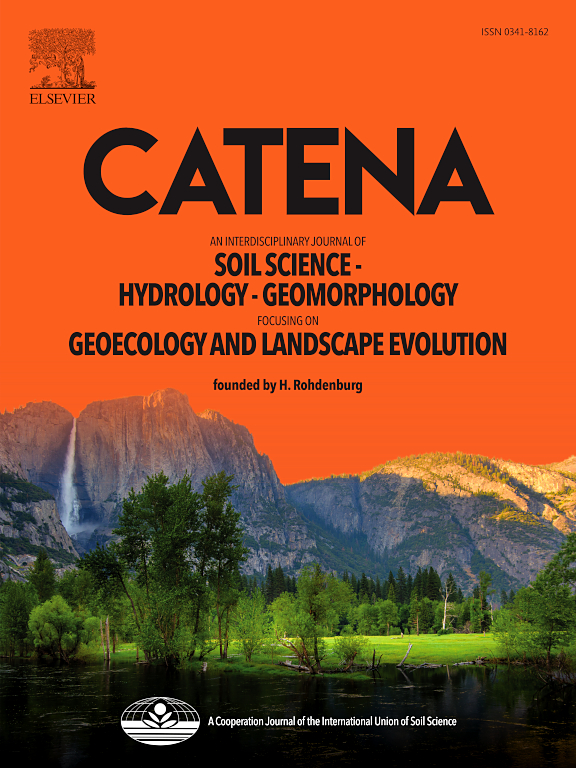Sedimentary facies drive the development of organic-rich Podzols from a tropical barrier island
IF 5.4
1区 农林科学
Q1 GEOSCIENCES, MULTIDISCIPLINARY
引用次数: 0
Abstract
Dissolved organic matter (DOM) retention in deep soil is an important process of carbon sequestration, especially for Podzols, which are soils with an accumulation of organic matter and/or oxides in the subsoil. Although DOM is immobilized at the soil subsurface by the saturation of organic complexes with metals (Fe and Al) during podzolization (i.e. the process of Podzol formation), such a chemical mechanism may have a minor effect in soils poor in Fe and Al. Here, we leverage the negligible content of organic-complexed Fe and Al in three Podzol profiles from Ilha Comprida (Southeastern Brazil) to determine the particle size distribution and sedimentary structures inherited from the parent material that enhances podzolization. The investigated Podzols have unique sequences of sedimentary facies, i.e., a body of sediments with a specific combination of mineral assemblages, fabrics, grain size, and depositional or penecontemporaneous structures, both biological and physical, reflecting specific depositional processes. Our results indicate that podzolization via DOM retention increases in response to two hydrologic mechanisms: (i) capillary break at the interface of sedimentary facies with a mean sand size of 2.6 ± 0.3 phi (small pores) over a layer of a mean sand size of 1.9 ± 0.2 phi (large pores); and (ii) physical barrier for vertical water percolation at the abrupt textural transition between sandy-over-clayey sedimentary facies. Both mechanisms influence the formation of the Bh and Bhm horizons. We suggest that studies on organic carbon dynamics and soil classification efforts should recognize the prowess of sedimentary facies and the contact between them in retaining substantial amounts of organic matter in deep soil.

沉积相驱动了热带堰洲岛富有机质灰泥岩的发育
深层土壤中溶解性有机质(DOM)的滞留是固碳的重要过程,特别是对于底土中有机质和/或氧化物积累较多的灰化土而言。虽然在灰化化过程(即灰化土形成过程)中,DOM通过与金属(铁和铝)的有机配合物的饱和在土壤地下被固定,但这种化学机制对缺乏铁和铝的土壤可能影响较小。我们利用来自巴西东南部Ilha Comprida的三个灰化土剖面中可忽略的有机配合铁和铝的含量来确定颗粒大小分布和继承自母物质的沉积结构,从而增强灰化土作用。所研究的灰泥岩具有独特的沉积相序列,即具有特定矿物组合、组构、粒度和沉积或准同生构造组合的沉积物体,反映了特定的沉积过程,包括生物和物理构造。研究结果表明,通过DOM滞留形成的灰化化过程主要受两种水文机制的影响:(i)平均粒径为2.6±0.3 phi(小孔隙)的沉积相界面的毛细断裂,覆盖了平均粒径为1.9±0.2 phi(大孔隙)的沉积相界面;(2)砂质-粘质沉积相结构突变时水垂向渗流的物理屏障。这两种机制都影响Bh和Bhm层的形成。我们建议有机碳动力学研究和土壤分类工作应认识到沉积相及其之间的联系在深层土壤中保留大量有机质的作用。
本文章由计算机程序翻译,如有差异,请以英文原文为准。
求助全文
约1分钟内获得全文
求助全文
来源期刊

Catena
环境科学-地球科学综合
CiteScore
10.50
自引率
9.70%
发文量
816
审稿时长
54 days
期刊介绍:
Catena publishes papers describing original field and laboratory investigations and reviews on geoecology and landscape evolution with emphasis on interdisciplinary aspects of soil science, hydrology and geomorphology. It aims to disseminate new knowledge and foster better understanding of the physical environment, of evolutionary sequences that have resulted in past and current landscapes, and of the natural processes that are likely to determine the fate of our terrestrial environment.
Papers within any one of the above topics are welcome provided they are of sufficiently wide interest and relevance.
 求助内容:
求助内容: 应助结果提醒方式:
应助结果提醒方式:


